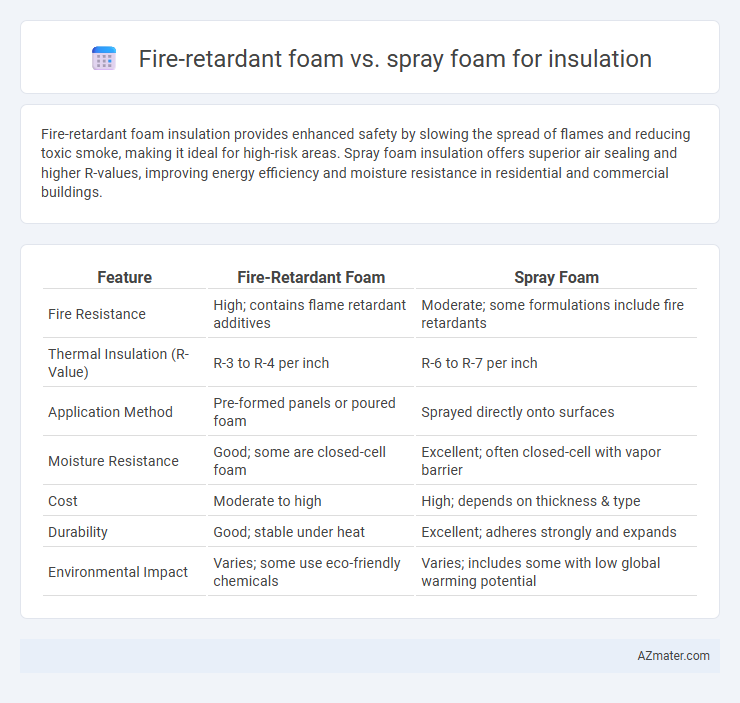Fire-retardant foam insulation provides enhanced safety by slowing the spread of flames and reducing toxic smoke, making it ideal for high-risk areas. Spray foam insulation offers superior air sealing and higher R-values, improving energy efficiency and moisture resistance in residential and commercial buildings.
Table of Comparison
| Feature | Fire-Retardant Foam | Spray Foam |
|---|---|---|
| Fire Resistance | High; contains flame retardant additives | Moderate; some formulations include fire retardants |
| Thermal Insulation (R-Value) | R-3 to R-4 per inch | R-6 to R-7 per inch |
| Application Method | Pre-formed panels or poured foam | Sprayed directly onto surfaces |
| Moisture Resistance | Good; some are closed-cell foam | Excellent; often closed-cell with vapor barrier |
| Cost | Moderate to high | High; depends on thickness & type |
| Durability | Good; stable under heat | Excellent; adheres strongly and expands |
| Environmental Impact | Varies; some use eco-friendly chemicals | Varies; includes some with low global warming potential |
Introduction to Fire-Retardant Foam and Spray Foam
Fire-retardant foam contains specialized additives that significantly reduce flammability and slow combustion, enhancing building safety by meeting rigorous fire codes. Spray foam insulation expands upon application, creating an airtight seal that improves energy efficiency while possessing variable fire resistance depending on its chemical composition. Understanding the distinctions in fire performance and insulation properties is critical when selecting between fire-retardant foam and standard spray foam for sustainable building projects.
Key Differences Between Fire-Retardant and Standard Spray Foam
Fire-retardant foam contains specialized chemical additives that significantly enhance its resistance to ignition and slow down flame spread compared to standard spray foam. Standard spray foam, while highly effective for thermal insulation and air sealing, lacks these enhanced fire-resistant properties and can ignite more easily under high heat. Building codes often require fire-retardant foam in areas where fire safety is critical, making it essential to choose the right foam based on specific regulatory and safety requirements.
Fire Safety Ratings and Compliance
Fire-retardant foam insulation typically features higher fire safety ratings due to its chemical additives that reduce flammability and slow combustion, meeting strict building codes like ASTM E84 and UL 723. Spray foam insulation, while offering excellent thermal performance, must be specially treated or coated with fire-retardant barriers to comply with fire safety standards and pass flame spread and smoke development criteria. Choosing fire-retardant foam ensures compliance with fire codes in residential and commercial applications, enhancing overall safety by minimizing fire hazards and increasing structural fire resistance.
Thermal Insulation Properties Comparison
Fire-retardant foam offers enhanced fire resistance while maintaining adequate thermal insulation properties, making it suitable for applications where safety standards are critical. Spray foam insulation typically provides superior thermal performance due to its higher R-values and excellent air-sealing capabilities, resulting in reduced heat transfer and improved energy efficiency. Comparing thermal insulation, spray foam generally outperforms fire-retardant foam, but fire-retardant variants are preferred in settings demanding stringent fire safety without substantial compromise on insulation quality.
Installation Process and Application Methods
Fire-retardant foam insulation involves a specialized chemical composition applied using high-pressure spray equipment, ensuring uniform coverage and enhanced fire resistance in walls and ceilings. Spray foam insulation is installed through a two-part mixture sprayed directly onto surfaces, rapidly expanding to fill gaps and providing superior air sealing and thermal protection. Both methods require professional application for optimal performance, but fire-retardant foam emphasizes fire safety standards critical in residential and commercial buildings.
Cost Factors: Fire-Retardant vs Spray Foam
Fire-retardant foam insulation typically costs 10-20% more than standard spray foam due to specialized chemicals that enhance flame resistance. Spray foam insulation offers higher R-values per inch, potentially reducing overall material needs and labor costs despite its initial price. Homeowners often weigh fire safety benefits against upfront expenses when deciding between fire-retardant foam and standard spray foam options.
Longevity and Durability in Various Environments
Fire-retardant foam offers enhanced longevity and durability in environments with high fire risk due to its chemical additives that resist combustion and maintain structural integrity under heat exposure. Spray foam insulation provides excellent long-term air and moisture sealing but may degrade faster in extreme UV or moisture conditions without proper protective coatings. Selecting between fire-retardant foam and standard spray foam depends on specific environmental stressors like fire hazard, humidity, and exposure to elements, which directly influence insulation lifespan and performance.
Environmental Impact and VOC Emissions
Fire-retardant foam insulation typically contains chemical additives designed to reduce flammability, often resulting in lower volatile organic compound (VOC) emissions compared to conventional spray foam, which can emit higher VOC levels during and after installation. Spray foam insulation, while offering superior air sealing and energy efficiency, may release isocyanates and other VOCs that contribute to indoor air pollution and have environmental persistence concerns. Both options require careful selection and ventilation strategies to minimize health risks and environmental impact associated with chemical off-gassing and long-term degradation.
Best Use Cases for Each Insulation Type
Fire-retardant foam insulation excels in scenarios requiring enhanced fire safety, such as in commercial buildings, multi-family housing, and areas with strict fire codes, providing a barrier that slows flame spread and adherence to safety regulations. Spray foam insulation is ideal for residential and commercial spaces seeking superior thermal performance and air sealing, particularly in irregular cavities, attics, and walls, improving energy efficiency and indoor comfort. Choosing between fire-retardant and spray foam depends on prioritizing fire resistance or insulation effectiveness according to building codes and environmental conditions.
Choosing the Right Insulation: Factors to Consider
Fire-retardant foam offers enhanced safety by resisting ignition and slowing flame spread, making it ideal for areas with stringent fire codes. Spray foam excels in airtightness and thermal insulation, providing superior energy efficiency and moisture control in both residential and commercial buildings. When choosing the right insulation, consider factors such as fire rating requirements, R-value performance, installation environment, and long-term durability to ensure optimal safety and energy savings.

Infographic: Fire-retardant foam vs Spray foam for Insulation
 azmater.com
azmater.com